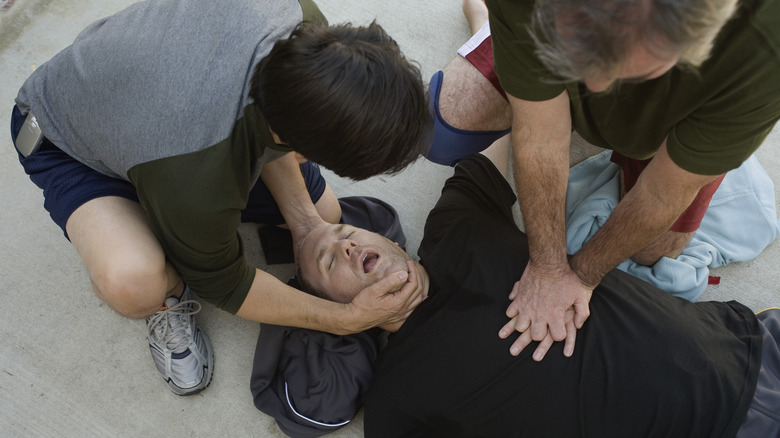How To Know When Arm Pain Is Actually A Heart Attack
Nearly 805,000 Americans experience a heart attack annually, according to data from the Centers for Disease Control and Prevention (CDC). However, heart attacks aren't always a one-time occurrence. In fact, every year, 605,000 people experience a heart attack for the first time, while 200,000 cases occur in those who have previously had one.
When the heart fails to receive enough blood flow, often due to plaque accumulation in the arteries, this can lead to a heart attack (via Mayo Clinic). Also referred to as a myocardial infarction, education and prevention are critical factors in reducing one's likelihood of a heart attack. This includes recognizing the signs of a heart attack in real time, since there are often red flags that warn one is imminent. These can begin to emerge as early as a few weeks prior to the cardiovascular event.
One common symptom of a heart attack is pain that affects one or both arms. However, this symptom can be experienced differently between men and women. Because arm pain can be caused by any number of things, how can we tell when it might be related to a heart attack?
How arm pain may differ between men and women
A tight muscle, pinched nerve, or a nasty bruise could all be responsible for one's arm pain. What makes heart attack-related arm pain stand apart, however, is where it first occurs, what parts of the body the pain spreads to, and its accompanying symptoms.
Often affecting the left arm, experts at Norton Healthcare explain that men usually experience heart attack-related arm pain that starts in the shoulder and makes its way down the arm or travels upwards towards the chin. This pain can come on abruptly. In the event that it's joined by feelings of tightness or compression in the chest, immediate medical attention is warranted.
For women, arm pain indicating a heart attack is not always so obvious. While men often experience this pain in the left arm, women may find it spreading down the left or right arm. Like men, this pain may affect the chin or shoulders, but may also extend to the upper back or abdomen, resembling symptoms of nausea or digestive distress. Keep an eye on any accompanying symptoms, as women are more prone to nausea, vomiting, shortness of breath, or back or jaw pain in relation to a heart attack. Similar to men, chest pain may also occur. Rather than coming on abruptly or severely, however, women may experience chest pain that comes in waves or lasts for several minutes.
Steps to take in the event of a heart attack
If you or someone around you is exhibiting symptoms of a heart attack, time is of the essence. Call for emergency services or have someone transport you or the individual to the nearest emergency room. If no help is available, you may need to transport yourself as a last resort.
If told to do so while waiting on emergency services, take nitroglycerin (via Mayo Clinic). Cleveland Clinic experts explain that nitroglycerin is a medication that prompts the blood vessels to relax and subsequently eases chest pain. Similarly, aspirin can help protect against blood clots and minimize damage to the heart. Consult with a medical professional, as taking aspirin may be advised.
Finally, if an individual appears to be having a heart attack and they are not breathing (or a pulse cannot be found), administer cardiopulmonary resuscitation (CPR). Untrained individuals should administer approximately 100 to 120 chest compressions per every 60 seconds. Those certified in CPR should issue 30 chest compressions followed by two mouth-to-mouth resuscitation breaths.



